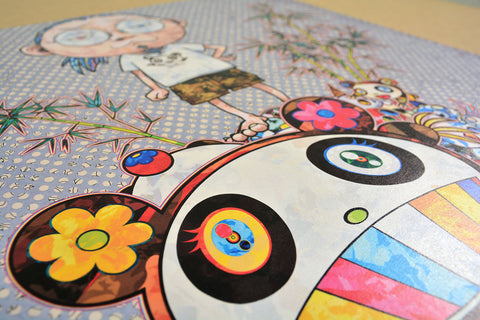
About Takashi Murakami's Limited Editions
, 9 min reading time

, 9 min reading time
Takashi Murakami's limited editions are many, although their characteristics vary greatly from one to another. The fact that there is a wide variety of themes, sizes, techniques and edition sizes means that Murakami has a large number of avid and loyal collectors.
His most common editions are those produced in runs of 300 copies and are made through offset lithography with different finishes. Whether it’s Mr. DOB, Kaikai Kiki, smiling flowers, colorful skulls, Flower Balls, self-portraits... all this iconography, so characteristic of Takashi Murakami's work, is available to the public thanks to his graphic work.
In Artetrama we have been working with Takashi Murakami's graphic work for more than 10 years, during all this time we can say that there are three aspects of the work of this Japanese artist that our clients have consulted us the most. These are the date, the signature and the technique.
Across Murakami’s editions, recurring specs help collectors navigate: most offset lithographs are in editions of 300, often enhanced by cold foil, hot foil, silver layers, spot or high‑gloss/UV varnish, and sometimes Diasec mounts on select releases; these finishing choices explain why two prints with the same image can feel radically different in light and surface. The “Flower Ball” family, Mr. DOB, Kaikai Kiki and skull motifs act like anchors in a vast catalog, while periodic pigment prints and silkscreens offer higher tactile relief and denser color planes for those prioritizing material presence.
The date:
Each and every one of the copies that have been published by Takashi Murakami have, in addition to his signature and numbering, an inscription with the copyright of the image. This copyright, which is usually found at the bottom of the work, contains the title of the work and a date. This date refers to the year in which the image that is reproduced in that edition was created and patented. The date that galleries and auction houses provide as information about the work is the date of publication of the limited edition, which usually does not match the date that appears on the copyright of the offset lithograph, silkscreen or archival pigment print in question. In other words, the date provided by the professionals is the date of creation of the limited edition on which the image is based, not the date of the copyright, which might have an earlier date.

BOKAN- Camouflage Pink (2013)
For cataloging and insurance purposes, it’s best practice to record both the edition publication year and the image copyright year; this avoids confusion when the image predates the print release and keeps collection records aligned with how auction houses and condition reports describe these works.
Signature placement and medium: Murakami usually signs his limited edition offset lithographs on the front lower right margin in ink (typically black, silver, or white depending on contrast), and he numbers the specific print alongside the signature (e.g., 123/300). This front signature‑and‑numbering convention is standard across most offset runs; the variations collectors notice primarily reflect stylistic changes in his autograph over time, not placement or the writing medium.
The signature:
As just mentioned, all of Takashi Murakami's graphic work is signed and numbered by himself. At some point, a Murakami collector will start comparing works and suddenly realize something strange: the signatures are different! Yes, Takashi Murakami's signature evolves from a more or less legible scrawl to large loops.
In his early works, Takashi Murakami limited himself to stamping his first name, Takashi, along with the year. From 2001 to 2004 his relatively legible signature changed to a similar but more fluid one. The first noticeable change in his signature occurs in 2005, when it becomes a wavy line. The line tends to flatten out, but generally remains the same until 2010. This linear signature actually proved useful during the period 2005-2010, as the second half of that period marks the beginning of increased production.
Takashi Murakami employs this type of signature until 2011, however, some of his works from early 2011 mark the transition from the looped line to a signature composed solely of loops, which has predominated in his editions since then. In 2020, the looped signature is maintained for his offset lithographs, but it is at this point that Mr. Murakami makes another change. As we can see in his new series of archival pigment prints and serigraphs, his signature returns to that linear image but incorporating graphics in the middle.
Where to look: signatures and numbering typically appear front, lower margin (right) in ink for offsets, with edition annotations such as “xxx/300” varying by series. When in doubt, request close, raking‑light photos of the signature, numbering, and any studio label to verify pressure, stroke order, and ink sheen.
|
|
|
Technique:
Murakami's enigmatic nature contributes greatly to his growing popularity. He is obsessed with breeding beetles, his puppy Pom, traditional Japan, the effects of World War II in Japan, and international pop culture. This amalgam of concerns makes his creative process very dynamic, but not without some side effects. On many occasions, his obsession for perfection has made his fans wait impatiently for works that were months late, as was the case with the Kansei series.
Although the process of creating Takashi Murakami's limited editions at his Kaikai Kiki factory is a mystery, certain techniques are recurrent in many of his editions. The most common editions are limited to 300 copies, all offset lithographs, however, other techniques such as cold or hot foil stamping, the use of silver or UV varnish appear in their descriptions.
Hot stamping consists of applying a metal foil to the paper with pressure, heat and a cutter. In contrast to this hot foil stamping method, there is a cold foil stamping option that works by applying the foil (metallized paper) as if it was an ink. The cold foil stamping process lends itself to gradients and halftones, unlike traditional hot foil stamping.
Thanks to cold foil stamping, many of Takashi Murakami's works have those gold or silver backgrounds that he likes so much and that refer to traditional Japanese painting. Works such as "The Golden Age: Hokkio Takashi" or "Kyoto: Korin" are examples of cold printing, which can be seen in the details or gold or silver backgrounds. When reference is made to the use of silver, Murakami's works adopt a pearly character that predominates, for example, in his limited editions "And then...", his self-portraits such as "I met a panda family" or "A space for philosophy" or in the diptych "Homage to Francis Bacon (Study for Head of Isabel Rawsthorne and George Dyer)".
Quick material note: cold foil is typically applied inline using a UV‑curable adhesive and can be overprinted to create metallic color gradients; hot foil is applied offline with heat and pressure via a die, producing crisper edges and, if desired, a lightly embossed tactility. Both appear in Murakami editions, but cold foil’s gradient capability explains the shimmering gold/silver grounds seen in Flower Balls and golden‑ground works that nod to Rinpa traditions.
 "The Golden Age: Hokkio Takashi" (2016) |
 I met a Panda Family (2013) |
As a summary, we could say that a Murakami collector can choose which pieces to acquire based on multiple factors, as we mentioned at the beginning of this article. The work of this Japanese artist is so wide and varied that becoming an expert is quite a challenge!
A practical way to build a collection is to start with a Flower Ball or Mr. DOB offset that demonstrates foil or silver effects, then add a motif from the Kaikai Kiki universe for breadth, and finally consider one pigment or screenprint for a richer surface profile. For deeper context on themes and market behavior, explore our guides to Murakami’s universe and browse current availability in the Takashi Murakami collection.